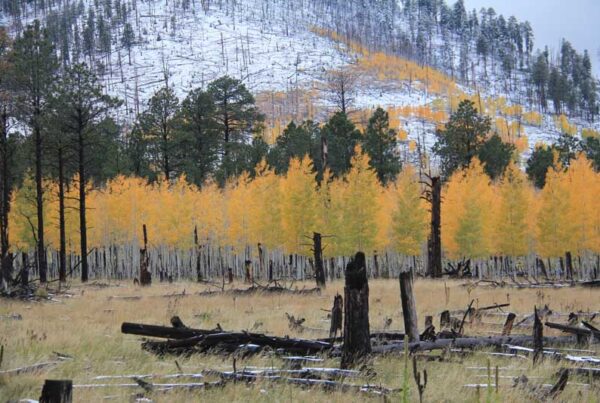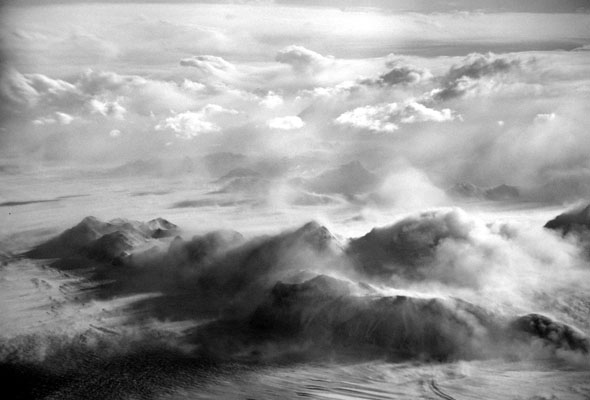Remote helicopter camps have been a recurring logistic feature of the U. S. Antarctic Program every several years since its origin following the International Geophysical Year in 1957-58. For my first Antarctic season, 1970-71, I was part of a field party from Ohio State connected to one of these installations. At that time, NSF granted field camps to individual proposals, and Ohio State had been funded that year for extensive geological reconnaissance in a 150-mile swath of the Transantarctic Mountains, about 450 miles south of McMurdo Station. We had three HU-1B (single engine) Huey helicopters, flown by Navy squadron VXE-6. We were a team of seven grad students, one undergrad, a couple of post docs, several faculty, and a mountaineer. Every day the helicopters would take us out to a field site and at the end of the day, bring us back to camp. The Navy crew included a half dozen pilots, about the same number of maintenance personnel, a weather watcher, a medic, and a cook.
The camp was built of Jamesways, modular, portable, quonset-style huts that were a holdover from the Korean War. They were warmed with gasoline-fueled Preway heaters. All the scientists slept together in one Jamesway, with a small, partitioned workspace at one end, two other Jamesways bunked the Navy pilots and enlisted men, a fourth served as a mess hall, and a small fifth unit was designated the comms shack. It only takes one person snoring in the room to mess with your sleep, but if there are two or three going off at once with different pitches and rhythms, sleep can become a desperate affair. Earplugs are issued when you climb onto the Hercules aircraft in Antarctica to preserve your hearing in the deafening noise at the back of the plane. They saved me in the Jamesway that season.
A decade later the approach to remote, helicopter logistics had evolved. In 1981-82 I was Chief Scientist at a remote, helo camp in northern Victoria Land (NVL), 400 miles north of McMurdo. Instead of the dozen and a half geologists that worked from the 1970-71 camp, we served 65 geologists (a record number at the time) from five countries. What made this manageable was that we put parties out in the field with tents, and in some cases snowmobiles, where they operated independently for much of the time. The camp used the same Jamesway set-up, flown in by Hercs. The Navy was still flying the helos, but the management and maintenance of camp, and the cooking was in the hands of the civilian contractor. A single mechanic maintained the camp generator and electrical system, the snow melter, the Caterpillar front-loader, and the snowmobiles. As Chief Scientist, I slept in the science Jamesway to keep a closer pulse on the camp, but a number of the geologists that stayed at the base camp set up tents at the edge of town in “the suburbs,” to escape the snorers, and gain a modicum of privacy.

The remote, helicopter-supported camp deployed in northern Victoria Land during the 1981–1982 field season. The six structures on the left side of the camp are Jamesways used as berthing facilities, a mess hall, a science laboratory, and a generator shack. The cargo yard extends to the right from these. The disrupted snow at the extreme right is a snow pit dug to supply the snow melter for the camp’s water supply. An LC-130 Hercules aircraft sits next to the camp runway. The two shiny objects immediately above the Herc are fuel bladders, giant “water beds” filled with jet fuel for the helicopters. Two of the three HU-1D helos assigned to the camp sit on the pad. I am aboard the third as it approaches camp.
In 1985-86 I worked with a party of three as a satellite of a remote, helo camp in the central Transantarctic Mountains, 350 miles south of McMurdo. The basecamp had been erected the previous season to host a meeting of international representatives from developing nations that had been agitating at the United Nations for wider inclusion in the Antarctic club. The motivation of the organizers of the meeting was to impress the participants with the severity of Antarctic field conditions and the expense of fielding a program. The basic operations were the same, but in addition to the Jamesway structures, the kitchen area was built of plywood with a plumbing system that included flush toilets and multiple showers. There never has been such a cushy set up for a one-off field camp so far from McMurdo Station.

A portion of the main kitchen facility built for the 1984-85 field camp that hosted dignitaries from the developming nations. The light-filled doorway leads to a 20-foot shaft and ladder for reaching the surface.
The next time that I participated in a remote, helo camp was in 2010-11, again as Chief Scientist. The camp was built on the same site as the camp in 1985-86. The remains of the old, plywood structure still existed, minus the plumbing, buried beneath about 20 feet of snow. In the 25 years since my previous association with a remote, helo camp, a number of changes had occurred. VXE-6 was disestablished on 31 March 1999, ending 44 years of distinguished service by the Navy to the U. S. Antarctic Program. The switch to a civilian contractor brought with it a more streamlined approach to operations. The Navy had always required that one helicopter sit on the ground as a safety precaution in the event of a necessary search and rescue operation, so the remote camps had three helos as part of their operation. The civilian contractor now stipulates only that if two helos are in the air at the same time that they must be operating within a prescribed distance from each other in the event of an S & R operation. Also, the Navy always required two pilots plus a crew member on a helo. The contractor requires only one pilot, a pilot in training, and no crew member.
Another change in logistics was the inclusion of de Havilland, Twin-Otter, fixed-wing aircraft in the field operations of remote camps. The normal operating radius of helicopters is 100 nautical miles. The addition of the Twin Otters has extended that range by many hundreds of miles. During the 2010-11 season, one of our parties was flown to the Reedy Glacier area more than 300 miles to the south, with a dog-leg to the South Pole for refueling enroute.
The camp itself, which served 100 scientists throughout the season, was considerably bigger than any I had previously experienced. The Jamesways were replaced by Rac-tents, similar in modular design to the Jamesways, but with low walls beneath the arches, so that there is more shoulder and head room inside if you are sitting near the side of the structure. The Rac-tents also have skylights, precluding the need for electrical lighting. All sleeping, except for small darkened structures for the helo and Otter crews, was done in individual tents in a “tent city” at the side of the camp. The cargo yard was so vast and far away from the main structures that some of us joked that we needed a GPS unit so we didn’t get lost when we were tending to our gear and samples.

The 2010-11 CTAM (Central Transantarctic Mountains) camp. A Twin Otter sits on the deck. The row of Rac-tents behind that begins with the mechanics tent, then the comms tent, then two science tents, then the long kitchen and mess, followed by a shower tent, a medical tent, and two sleeping tents for helo and Otter crews. Beyond that is "Tent City." To the left of the Rac-tent row are five dark outhouses. Beyond that is the camp's cargo yard, and to the left of that the science cargo yard.
In many ways the remote camps have become more efficient over the decades, but with regard to support personnel they have not. During the 2010-11 season, the camp staff, not counting pilots and mechanics, numbered 18. This included a camp manager, a camp supervisor, a field support coordinator, two weather observers, a paramedic, a fuels operator, a cargo specialist, three general assistants, a chef, two sous chefs, two heavy equipment operators, a heavy equipment mechanic, and a snowmobile mechanic, plus a rotating dining attendant, and for the better part of the season, a carpenter.

